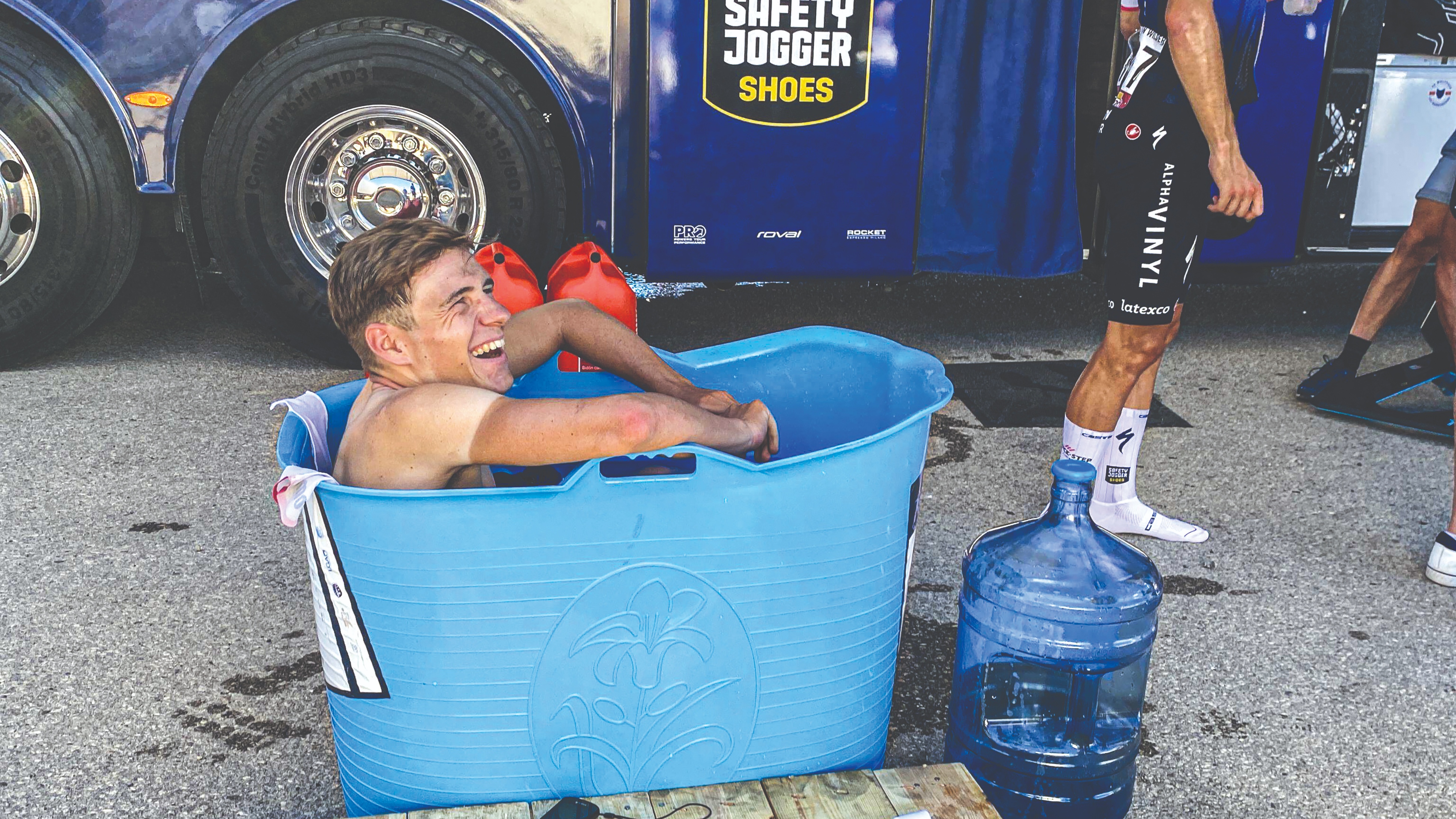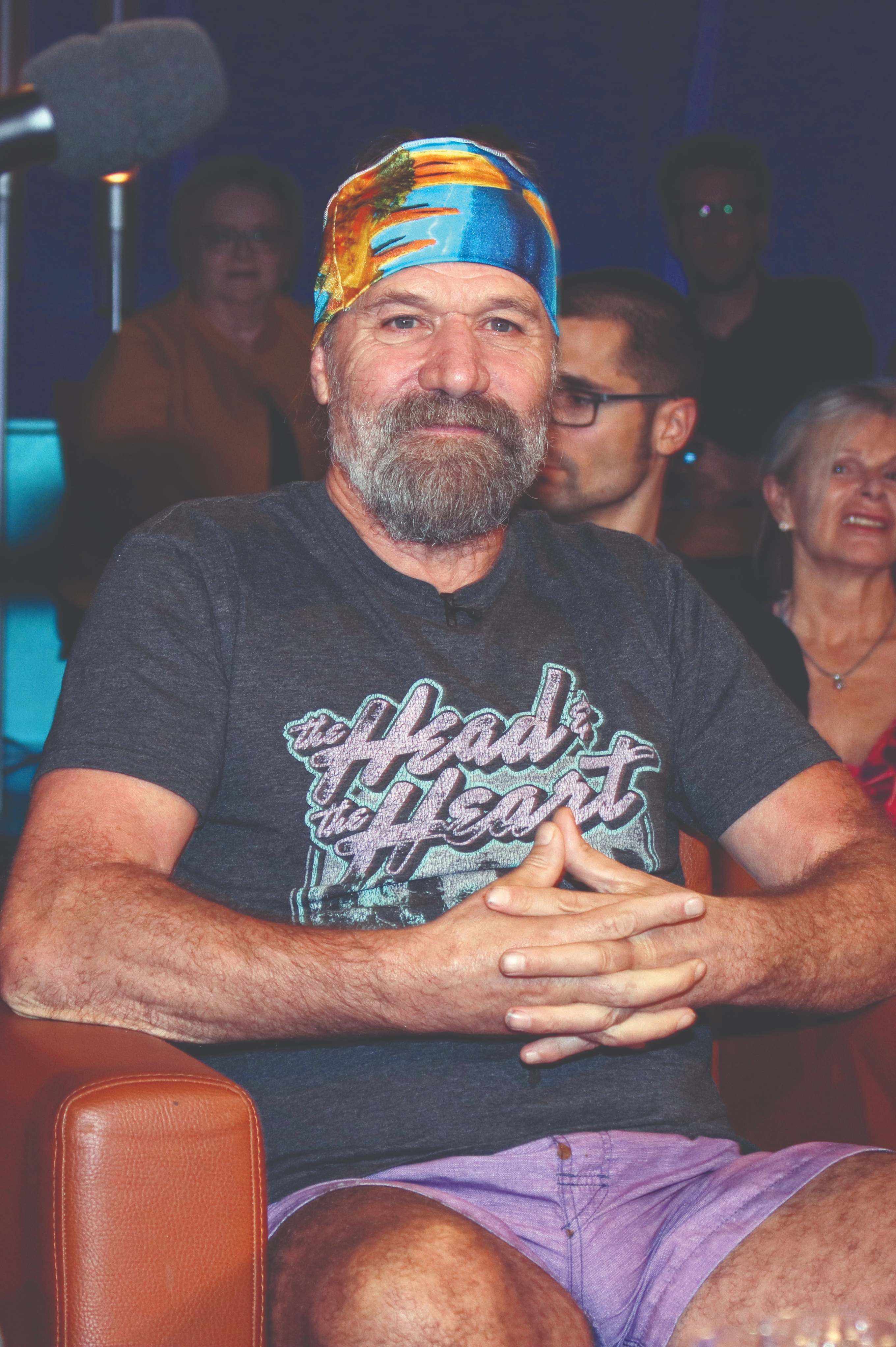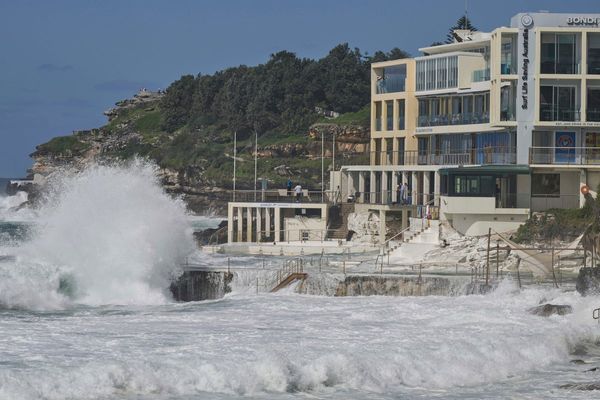
Cold plunges, high-street cryotherapy chambers and the much-publicised Wim Hof method have made freezing recovery therapies a hot topic. Can short, sharp exposures to very cold temperatures really benefit cyclists, or do the related risks – not to mention to the discomfort – outweigh any potential gains?
“We use cold water immersion during the summer Tours and its chief benefits are body cooling in the heat and faster muscle recovery after exercise,” Loïc Cuigniez, medic with team Lotto-Dstny tells Cycling Weekly. “The cold baths induce an anti-inflammatory response, reducing secondary muscle damage and enhancing muscle recovery. Since heat also adds extra stress to the heart, the sooner the riders cool down, the better they recover.”
Cold therapy comes in a couple of formats: Firstly, whole body cryotherapy (WBC), exposure to extremely low temperatures in specialised chambers or with devices delivering cold air to specific areas of the body. Secondly, ice baths and cold-water immersion (CWI), submerging the body in cold water. While both aim to achieve similar physiological effects, cryotherapy offers the advantage of precise temperature control and shorter exposure times.
Whole-body cryotherapy involves immersing the entire body in sub-zero temperatures for a brief period, typically two to four minutes. This makes it more convenient for elite athletes with busy schedules. The Leicester City football team that won the Premier League in 2016 used a cryotherapy chamber to speed up player recovery during a period of jam-packed fixtures. But since the ‘iceman’ Wim Hof cometh, there has been a heightened interest in the purported benefits of simple ice baths.
Proponents of ice baths believe that their benefits extend beyond simply cooling down and ramping up recovery. Sceptics, on the other hand, warn that taking such cold plunges to an extreme could be at best a waste of time and at worst potentially life-threatening.
The benefits
Lotto Dstny’s team medic Loïc Cuigniez runs us through a pro rider’s warm-down and recovery session
■ During or directly after the ice bath, they have a recovery shake with carbs and proteins, supplied by Precision Fuel and Hydration.
■ We also promote active recovery sessions post-race with a 15-minute easy spin on the rollers.
■ During the bus ride to the hotel, some riders wear compression garments (Normatec) before the soigneurs do their massage.
All of the above help to reduce perceived exertion the next day, making riders more resilient and physically and mentally ready to compete again.
Cryotherapy has been shown to be an effective post-exercise recovery strategy, with research demonstrating reduced delayed onset muscle soreness (DOMS),” explains Dr Laura Wilson, a senior lecturer in exercise physiology and nutrition at the London Sport Institute based at Middlesex University. She has carried out studies with endurance athletes to measure the impact of cryo chambers and cold-water immersion on performance and recovery. “It’s also led to reduced ratings of perceived exertion (RPE) experienced in subsequent exercise bouts following cooling.”
While cryotherapy chambers offer the most intense, hi-tech chillout, they’re not cheap and far from mobile. An ice bath can be just as effective, says Wilson. “Cold water immersion remains the most common cryotherapy modality in practice. Other methods including ice pack application or whole body cryotherapy using cooling chambers have all demonstrated similar results.”
For Lotto-Dstny riders, there’s no need for a cryo chamber. “We just have a portable bath on the team bus,” says Cuigeniez. “We fill it at the finish line with cold water of 10-15°C and riders go in with their legs immersed for five minutes.” At UAE Team Emirates, two-time Tour de France winner Tadej Pogačar is another pro who values a post-race quick dip in a paddling pool full of ice. The Slovenian is, according to his medical director Adriano Rotunno, one of a number to take an ice bath for its psychological benefits as much as the physical ones.
“It’s not intended for recovery or performance but just to allow the rider to feel better after the stage,” Rotunno told Dutch newspaper Het Laatste Nieuws after Pogačar took a dip during the first stage of the 2023 Tour in Bilbao. “We don’t do prolonged submersions, because the longer the submersion, the more deleterious it is to performance,” the doctor explained. “It’s purely to cool down body temperature – an acute submersion, we go in and out for less than a minute at a healthy temperature.” Pogačar’s team-mate Adam Yates has also taken to cooling down in the team’s ice-filled inflatable paddling pool after a stage – perhaps no surprise from a rider who partially blamed the heat of the French summer for the time he lost at the Tour in 2018.
Resilience boost
It’s the reported ‘feel better’ benefits of cold-water immersion that have piqued the interest of Tom Haines, sport and exercise psychologist and coach at the University of Nottingham. “I’m very much of the school that says if you feel you’re getting gains from it, then happy days, crack on with it,” says Haines. “There’s also the often-overlooked benefit that comes from putting yourself through something unpleasant like an ice bath every few days.” He is referring here to mental forbearance. “You’ll find that your gruelling training hill ride in the freezing rain is marginally easier to manage mentally if you can tell yourself, ‘this is nothing compared to that ice bath yesterday’.”
Backing up this theory is a 2020 study published in the International Journal of Environmental Research and Public Health that found that CWI can have a positive effect on the endocrine system and the psyche, including reducing the symptoms of depression.
Cold starts
Amateur rider Michael Kanizay, 56, from Melbourne, Australia, is a firm believer in cold water immersion: “I don’t feel as strong on the bike if I ride without first doing cold water immersion (CWI). I started daily CWI back in March of 2019 out of curiosity. I’d heard Wim Hof interviewed on a podcast and I already used the yogic breathing techniques Wim suggested to overcome cold sensations on the bike and while running. “As a competitive cyclist in C grade/Cat 3 and Masters B grade/ Cat 2, riding six days a week, CWI has become a cornerstone of my routine. I use a salt water chlorinated pool at home, immersing myself six times, focusing on breathing for about six seconds each time. Initially, with water around 20°C, it was refreshing, but as winter sets in, temperatures drop to 10°C. Even when away from home, I substitute with a 90-second cold shower. “Physically, CWI invigorates me, enhancing my alertness and energy. Skipping it leaves me lacking in vitality. Lowering my core body temperature potentially increases performance capacity, especially during intense indoor rides when overheating hampers performance. My improved tolerance to cold conditions is evident during group rides in colder months. “There’s a buzz associated with CWI, which I later found out is due to dopamine release. Being able to do something that takes me out of my comfort zone is very empowering and I feel like I take an element of that with me into the day.”
The usefulness of cold-water immersion isn’t limited to post-ride cooling, according to Haines. “Ice baths have an effect on your sympathetic nervous system, immediately ramping up your body’s activation hormones,” he says. “The brain thinks ‘oh sh**t, this is trouble’ so you get that hit of adrenaline, noradrenaline, cortisol and endorphins. There are these chemicals rushing around your body, making you feel invincible.”
It’s a point echoed by Jorge Lopes Storniolo, physiologist in the department of pathophysiology and transplantation at the University of Milan. “Before exercise, intense cold exposure may positively affect the body, from the autonomic nervous system point of view,” Storniolo explains. His Milan research team carried out a study among 28 cyclists, monitoring their heart activity before, during, and after exercise, to measure how cryotherapy affected performance. WBC was found to increase time to exhaustion by around 12-14% and shortened heart?rate recovery times.
“We found that WBC improves the overall ability to produce mechanical power,” says Storniolo. “The time to exert maximal work increases proportionately to a persistent reduction of sympathetic tone [baseline stimulation of the sympathetic nervous system] after the single WBC session.” Though much of the research surrounding cryotherapy focuses on post-exercise recovery strategies, its potential for manipulating core temperatures and enhancing exercise performance is largely untapped.
“During exercise, core temperature increases due to heat production resulting from muscular contractions,” says Laura Wilson, “and this increases ‘thermal strain’ which negatively impacts endurance performance. But cryotherapy can be used before exercise to reduce core temperature, thereby allowing cyclists to exercise for longer, or tolerate higher environmental temperatures for longer.”
The 'Scottish shower'
“Cryotherapy can be an effective intervention for pro and amateur cyclists alike,” insists Wilson, who recommends applying it as soon as reasonably possible after a race. “The processes that lead to exercise-induced muscle damage (EIMD) and the resultant symptoms – soreness and swelling, etc – are initiated as soon as exercise begins, so the earlier you can apply cryotherapy, the more effective it is likely to be.”
Popping into a cryotherapy chamber or even having a tin bath full of ice at the end of Sunday long ride isn’t an easy option for most of us. But a ‘Scottish Shower’ is. “Simply turning the shower to cold for a minute before getting out is a gradual way of acclimatising to cold water immersion,” suggests Tom Haines. The merits of alternating between hot and cold showers to induce some of the benefits of cold-water immersion are backed up by research published in the Journal of Physical Therapy in Sport. “Around 10-15 minutes at 10-15°C is ideal,” says Wilson, “and this temperature is likely achievable from the cold water tap at home.”
Potential pitfalls
While cryo chambers are appearing on the high-street and ice plunge tanks become the latest must-have home recovery accessory, there are safety concerns among some experts. Rapid immersion in icy water poses risks including hypothermia, frostbite, and shock. Taking an ice-cold plunge has been linked to at least one fatality in the US, prompting Professor Mike Tipton from the extreme environments laboratory at the University of Portsmouth to issue a warning. “I wouldn’t do anything that puts such an amount of stress on the body without having a check-up that I was fit and healthy enough to do it,” he says.

The Wim Hof method’s emphasis on holding one’s breath and enduring extreme cold exposure has come in for scrutiny among fears that the technique may also deprive their brain of oxygen, increasing the risk of fainting or hypoxic brain injury. Prof Tipton has reviewed much of the academic research available so far and pours cold water on many of the purported benefits of cold-water immersion for athletes. “The majority of current research is descriptive in nature and therefore contributes a limited amount to the understanding of the potential mechanisms underpinning the effects of specific recovery strategies,” he tells CW. “There are many areas that future mechanistic research should address, with the most pertinent topics being the effects of water temperature, hydrostatic pressure and the application following different exercise types.”
According to Tipton, you may be better off doing an active warm-down on the rollers than taking a cold dip. Further examination of research (Peake et al. 2017) backs this up, suggesting that “CWI is no more effective than active recovery for reducing inflammation or cellular stress in this single-bout exercise model.” On the subject of inflammation, Tipton says: “If CWI reduces the inflammatory response to exercise-induced trauma, it may in fact be counter-productive.” Tom Haines shares this view: “Using ice baths for rapid recovery after a hot race is fine, but dampening inflammation during recovery is something I’m sceptical about. You don’t want to reduce inflammation rapidly because it’s part of the process that helps us fully recover, repair and build back stronger. Why would we want to stop that?”
Elite cycling teams aren’t about to ditch the cold bath or post-ride ‘Scottish shower’ just yet, though. As a means of cooling the body down and inducing some perception of enhanced recovery, it remains part of the pros’ armoury. As Haines points out, if dipping your aching legs in a cold bath isn’t doing you any harm and feels good, then why not do it. But when it comes to setting up a Lebron James ice tub in the garden, the best advice seem to be: don’t take a shocking ice plunge alone, don’t do it without your GP’s say-so and don’t do it at the sacrifice of well-established and fully tested recovery methods such as warm-down exercise, the right nutrition and a decent night’s sleep.







